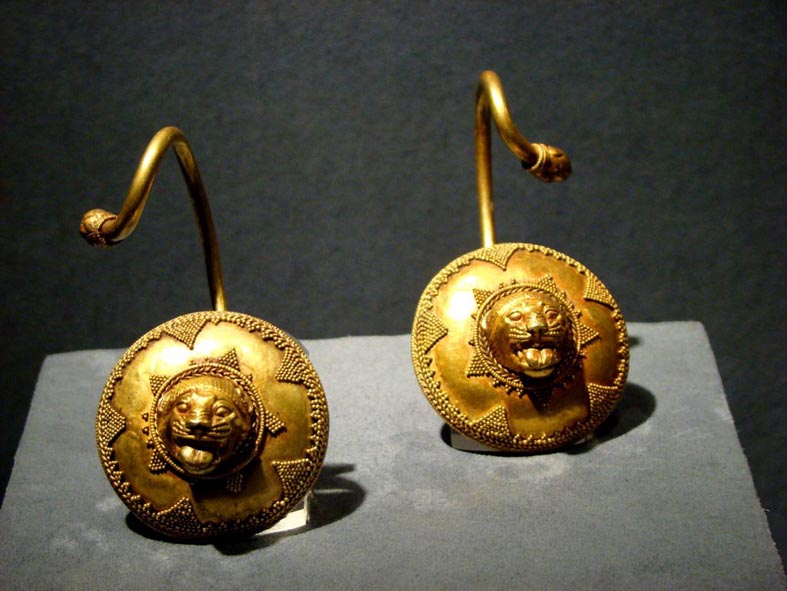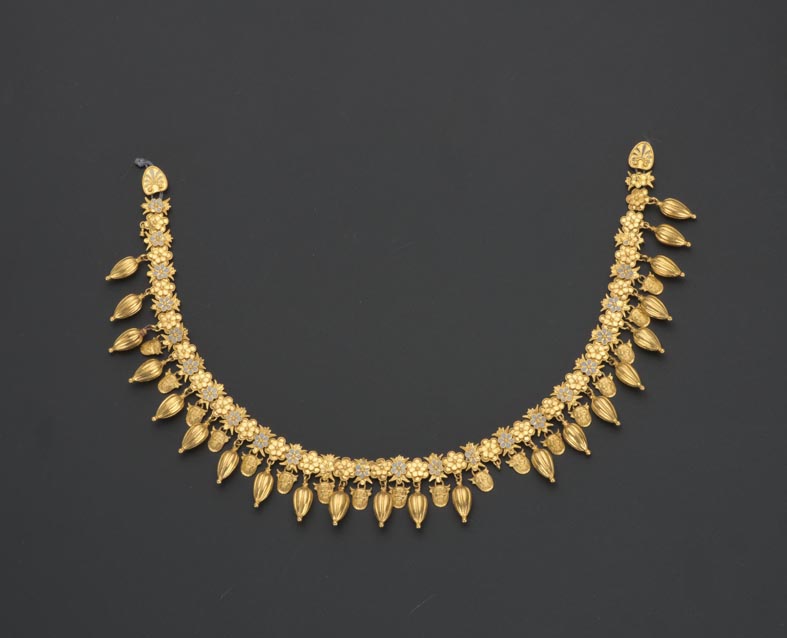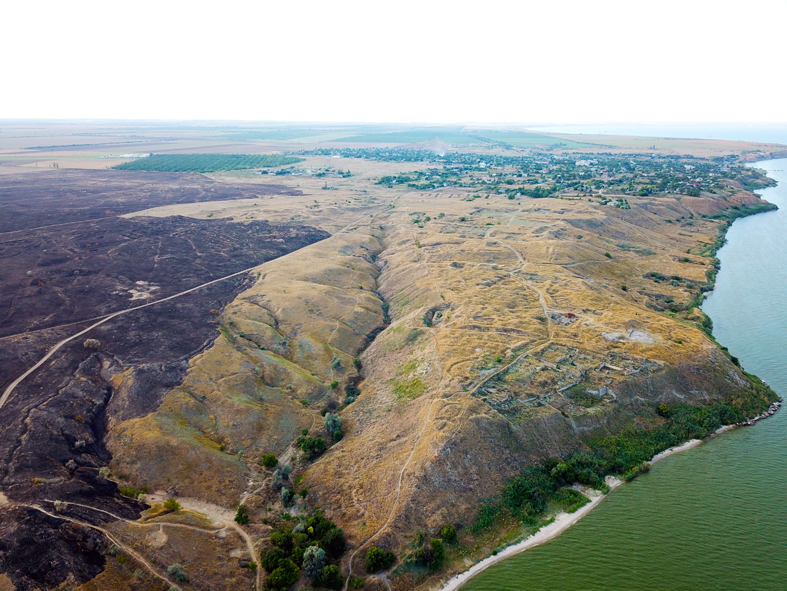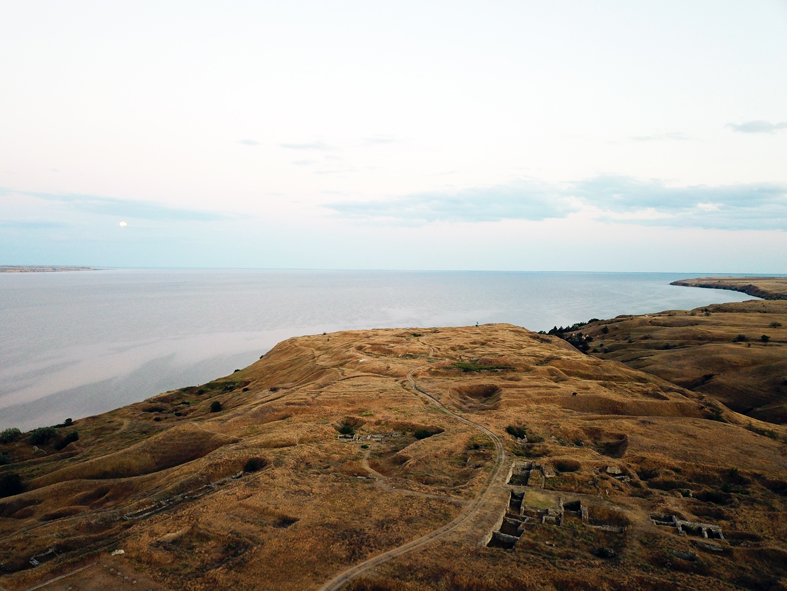Випуск 13. Вкрадені прикраси — золоті сережки VI ст. до н. е. з Ольвійського некрополя
Систематичні розкопки на території Ольвії (Миколаївська область, Україна) та її некрополя проводились від 1901 року під керівництвом археолога Бориса Фармаковського, який за цей час лише на некрополі міста відкрив близько тисячі різночасових поховань.
Від початку двадцятого століття і до жовтневого перевороту найцінніші ольвійські знахідки, зазвичай, забирали до найбільших музеїв Російської імперії — у Москві та Санкт-Петербурзі. Деякі знахідки масового характеру все ж потрапляли до музеїв в Одесі (заснований 1825 р.) та Миколаєві (1913 р.), співробітники яких зберігали та досліджували артефакти, виявлені під час розкопок на території Північного Причорномор’я. Вивезення найатрактивніших знахідок формально регламентувалося «Відкритим листом», що надавав право метрополії обирати найкращі (а фактично найкоштовніші) предмети для своїх музеїв (детальніше — читайте у випуску 2). У випадку з Ольвією, від 1909 року весь матеріал без винятку поступав до Ермітажу. Серед безлічі античних предметів з території Ольвії, Пантікапею, Херсонесу та інших античних полісів Північного Причорномор'я, росіяни вивезли й золоті сережки VI ст. до н. е. з Ольвійського некрополя.
Прикраси було виявлено в одній з могил (№ 100) Ольвійського некрополя архаїчного часу під час археологічних розкопок 1913 року під керівництвом Бориса Фармаковського. Вірогідно, що поховання належало одній із заможних мешканок поліса. Могила містила залишки дерев'яного саркофага з кістяними обкладками та окраскою.
По обидві сторони від голови знайшли вушні прикраси, по одній з кожної сторони. Разом з сережками виявили багатий поховальний інвентар — золотий перстень, золоте намисто, кілька золотих бляшок, бронзове дзеркало, алебастровий алабастр та керамічний посуд. Комплекс датували третьою чвертю VI ст. до н. е.
Вивезені золоті сережки мають доволі просту форму та порівняно нескладну обробку. Однак якість виконання рельєфу в техніці зерні дозволяє віднести їх до кращих ранніх творів ювелірного мистецтва. Ці парні прикраси одягали поверх вуха так, щоб велика частина знаходилась попід вухом. Тож сережки складаються з двох основних частин — золотого дроту з фігурним навершям (що проходив за вухом та кріпився зверху), та рельєфного золотого щитка округлої форми. Щиток має посередині фігурне зображення голови лева у фас з відкритою пащею. Голова лева виготовлена настільки майстерно, що ми маємо змогу роздивитися очі, ніс, вуса, гриву та висунутий язик тварини. Маленькі деталі виготовлені у техніці паяння зерні.
Сережки (під польовим номером 0.1913.444), разом зі всім археологічним комплексом потрапили до колекції Державного Ермітажу у Санкт-Петербурзі (Росія). Російський музей наразі не експонує ці знахідки, тож вірогідно вони перебувають у фондах музею. Зауважимо, що до Ермітажу вивезли як мінімум п’ять подібних парних прикрас одного типу, знайдених на Ольвійському некрополі архаїчного часу. Слід зазначити, що зараз неможливо відстежити конкретне місцезнаходження певних предметів (в тому числі й сережок), адже «відкрита наукова база» музею має лише невелику кількість предметів у вільному доступі. У цій базі немає навіть позначки про походження предметів з Ольвії, що наводить на думку, що ця інформація приховується навмисно. Проте, дякуючи багатьом попереднім науковим публікаціям (переважно радянських часів) ми маємо докази того, що велика кількість матеріалів з Ольвії, у тому числі золоті сережки, про які йдеться у дописі, зберігаються саме там.
Ірина Чечуліна,
доктор філософії, науковий співробітник відділу античної археології, ІА НАН України
Release 13. Stolen jewellery — gold earrings of the 6th century BC from the Necropolis of Olbia
Systematic excavations on the territory of Olbia (Mykolaiv region, Ukraine) and its necropolis has been conducted since 1901 under the guidance of archaeologist Borys Farmakovsky, who during this time discovered about a thousand burials of different periods just in the necropolis of the city.
From the beginning of the 20th century until the October Revolution the most valuable Olbian discoveries were usually taken to the largest museums of the Russian Empire located in Moscow and St. Petersburg. Some of the most common finds of a mass nature still ended up in museums of Odessa (founded in 1825) and Mykolaiv (founded in 1913), whose employees preserved and researched artifacts discovered during excavations on the territory of the North Black Sea region. Removal of the most attractive finds was formally regulated by the «Open Letter», which gave the right to the metropolis to choose the best (and in fact the most valuable) items for its museums (for more details see release 2).
In the case of Olbia, since 1909, all the material without exception has entered the Hermitage. Among the many antique items from the territory of Olbia, Panticapae, Chersonesus and other ancient cities of the North Black Sea region, the Russians also exported gold earrings of the 6th century BC discovered in the Necropolis of Olbia.
Jewellery was found in one of the graves (No. 100) of the archaic necropolis of Olbia during archaeological excavations in 1913 led by Borys Farmakovsky. It is likely that the burial belonged to one of the wealthy residents of the polis. The grave contained the remains of a wood sarcophagus with bone plates and paintings.
Ear ornaments were found on both sides of the head. Apart from the earrings, rich burial equipment was discovered that consisted of:
— a gold ring, gold necklace, several gold plaques, bronze mirror, alabaster alabastron and ceramic dishes. The complex was dated the third quarter of the 6th century BC.
The exported gold earrings have a rather simple shape and relatively simple processing. However, the quality of the relief made in the granulation technique allows us to classify them among the best early works of jewellery art. These pairs of jewellery were worn over the ear so that a large part overlapped under the ear. So earrings consisted of two main parts — a gold wire with a shaped top (which passed behind the ear and was attached from above), and an embossed golden round shield. In the middle of the shield, there is a figure image of a lion's head front view with an open mouth. Lion's head is performed so skillfully that we can see the eyes, nose, whiskers, mane and protruding tongue of the animal. Small parts are made in granulation soldering techniques.
Earrings (under field number 0.1913.444), together with the whole archaeological complex entered the collection of the State Hermitage in St. Petersburg (Russia). The Russian Museum currently does not exhibit these finds, so they are probably kept in the museum fund collections. It should be noted that at least five similar paired ornaments of the same type, found at the archaic Necropolis of Olbia were taken to the Hermitage. Currently, it is impossible to trace the exact location of certain items (including earrings), because the «open access scientific database» of the museum provides free access only to a limited number of items. This database does not even contain information about the Olbian origin of the artifacts. Obviously, such information is being withheld on purpose. However, thanks to many previous scientific publications (mainly in Soviet time) we have evidence that a large number of materials from Olbia, including the gold earrings mentioned in this release, are kept right there.
Iryna Chechulina,
Dr., Department of ancient archaeology, Institute of Archaeology of National Academy of Science of Ukraine

Золоті сережки VI ст. до н. е. з Ольвійського некрополя
Golden earrings of the 6th century BC from Necropolis of Olbia
Джерело | Source: spbtourkit.ru

Намисто із сорока восьми пронизок з Пантікапею (кінець V — початок IV ст. до н. е.)
Necklace of forty-eight tubular beads from Panticapae (late 5th — early 4th century BC)
Джерело | Source: open catalogue of the State Hermitage Museum


Вигляд на Ольвійський поліс
View of the Olbia polis
Фото | Photo: Юрія Пуголовка | Yuri Pugolovok
15.12.2022
Проєкт здійснено за підтримки Стабілізаційного фонду культури й освіти Федерального міністерства закордонних справ Німеччини та Goethe-Institut. goethe.de
The project is funded by the Stabilisation Fund for Culture and Education of the German Federal Foreign Office and the Goethe-Institut. goethe.de








